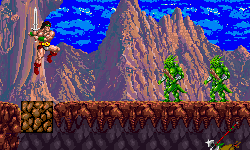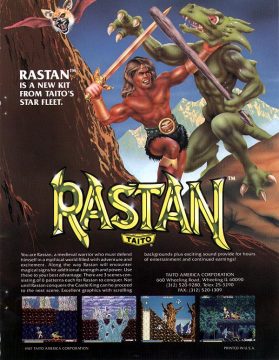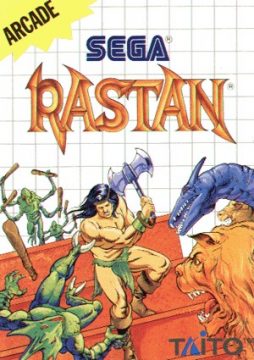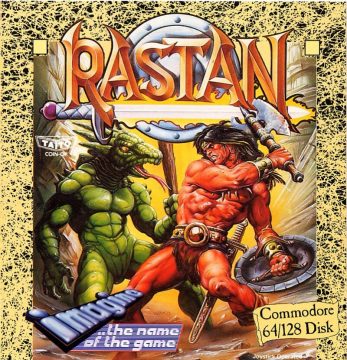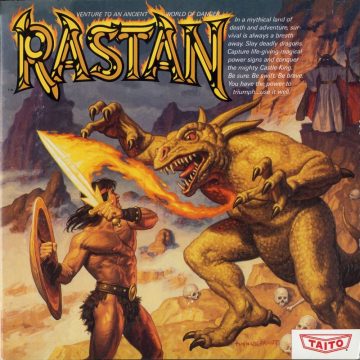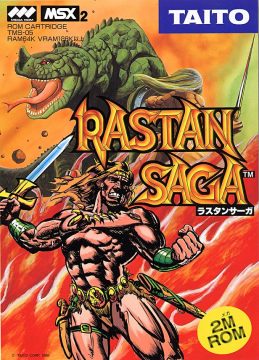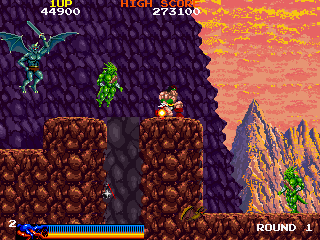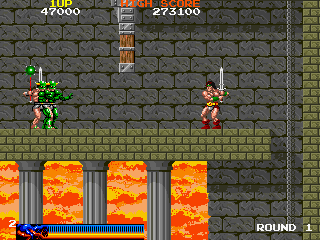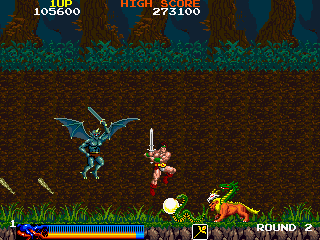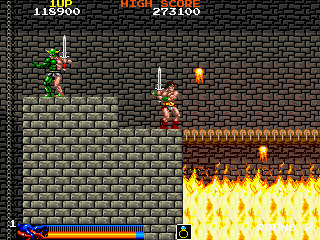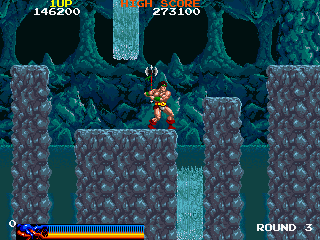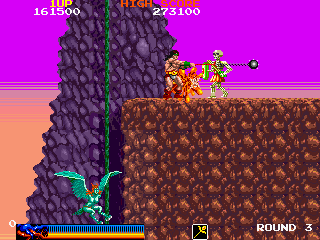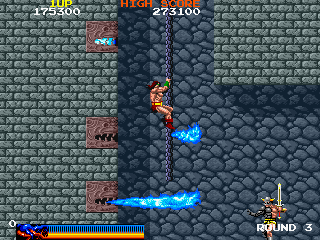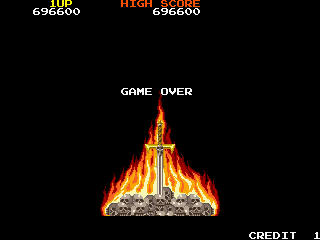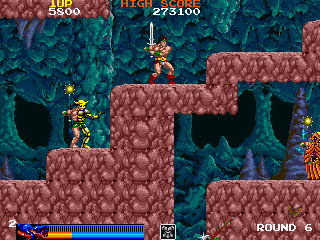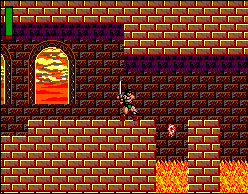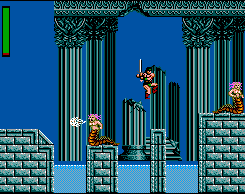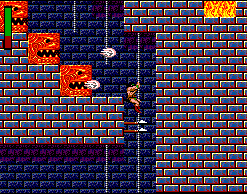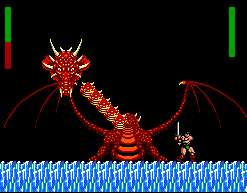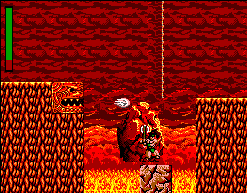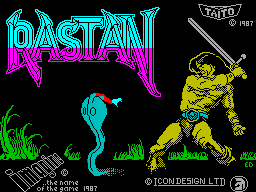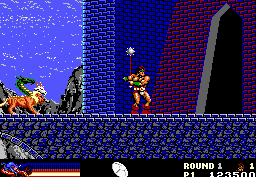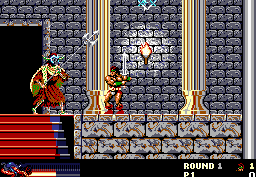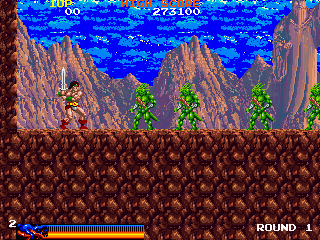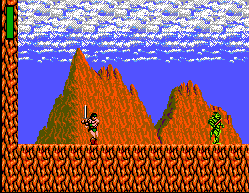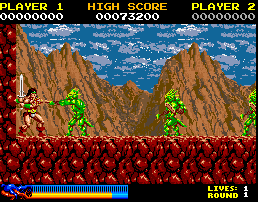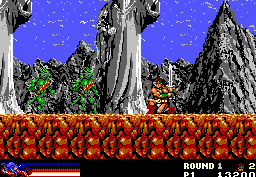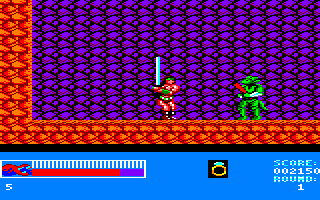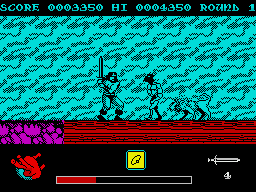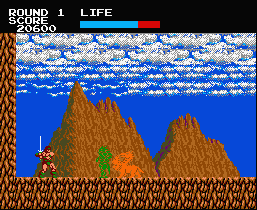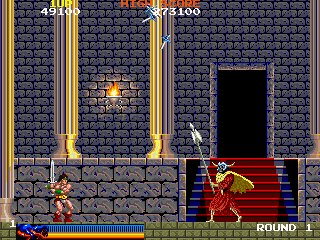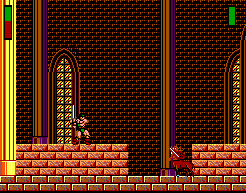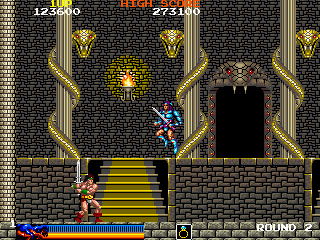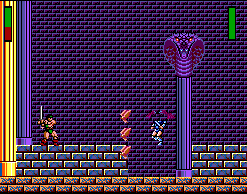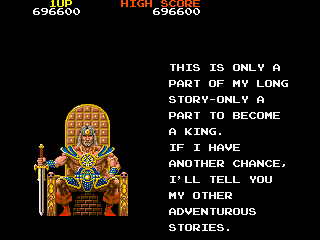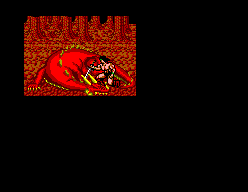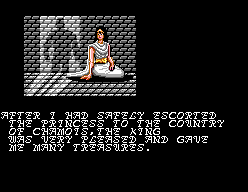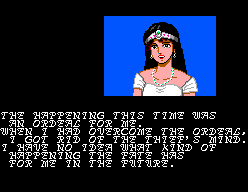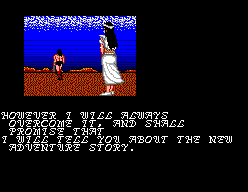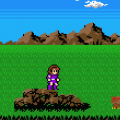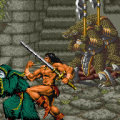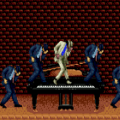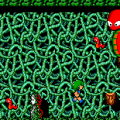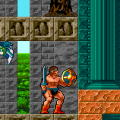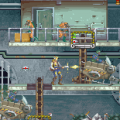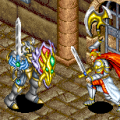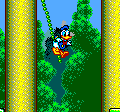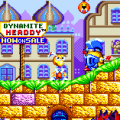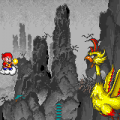Released in arcades in 1987, Taito’s Rastan was one of the best fantasy action-platformers of its time. The hero, the titular Rastan, is a clear clone of author Robert E. Howard’s most famous creation, Conan. The arcade game’s attract screens include a picture of an aged Rastan sitting on a throne (brazenly aping the final shot of Conan the Barbarian from 1982), with first person narration from Rastan about how he used to be a thief and a murderer, and that he will tell you of his days of high adventure.
When starting, you get an intro screen of Rastan walking through a stormy environment. You learn that he’s made a deal with a princess wherein he’ll slay a dragon in exchange for all the treasures of the kingdom of Ceim. This introduction is not present in the European and US releases of the game. It’s notable how Rastan’s motives mirror Conan’s in that he is altruistic, for a price.
Gameplay-wise, enemies constantly swarm Rastan, so one needs to keep moving to be successful. First off, the height Rastan jumps differs depending on how long you hold down the corresponding button. Also, he doesn’t have to stop moving to attack. This lets the game reward skilled players, since with proper timing, you can effectively charge through and destroy hordes of lesser enemies quickly. On top of this, the game world can scroll in any direction and is often several screens high, giving you a few paths to take through each area. Finally, Rastan can attack both upwards and downwards while in mid-air.
Every aspect of Rastan‘s design follows this trend of providing obstacles that, while challenging, reward the player with faster progression for knowing the controls. The greatest example of this is found with the boss fights and the castles the bosses reside in. Each of Rastan‘s six levels is broken into two segments. The first involves charging through an outdoor area, slaying dozens of weaklings. The second is where things get more interesting. Reaching the end of each outdoor area brings you to the entrance to a large castle. The castles also feature more pitfalls, spikes, and other such traps to keep you occupied. After negotiating them, you finally reach the level’s boss. Each one looks radically different from the other, and they all have very different abilities and even unique cosmetic flourishes in each of their backgrounds (the stone snakes sculpted around the columns at the end of the second level are a real standout). In an inspired touch, the programmers portray this not only in level design, but also from an artistic standpoint, as the time of day (and even the weather) changes as time passes, and the number of enemies increases.
Rastan has only a few items to aid him in his quest. Weaponry includes a sword that shoots fire (excellent), an axe (high power), and a morning star (same power as normal, but much longer range). Outside of these, there are several specific items dropped by enemies that can increase your life, or give you temporary protection from physical or magical attacks.
Graphically, the game is lavishly detailed for its time. While background tiles are recycled throughout, they’re not only recolored but re-combined in such a way that no two stages look exactly alike. It is also one of the first times that weather and sunlight changes were accomplished in a video game with such refinement and timing.
Rastan faces enemies ranging from lizard men to multi-armed creatures to chimera. True to the nature of the Robert E. Howard works that inspired the game, these foes die in a quick explosion of blood. The action is consistently fast, and everything is nicely animated. Extra attention was paid to Rastan’s attack animation, which is impressively smooth.
Aurally, Rastan is near-flawless. There are only three in-game songs (one for outdoor segments, one for castles, and one for boss fights) but each perfectly evokes an atmosphere of ceaseless violence. All three songs are impressive works, as they very clearly invoke the original style of Basil Poledouris’ score for Conan the Barbarian while still being original compositions. The song used during boss fights is especially intense due to its high quality drum effects, and the soundtrack was composed by Naoto Yagishita and Masahiko Takaki.
Rastan‘s sound effects are generally typical of the era, but Rastan himself has a few vocalized screams and grunts that are very clear. There’s also an excruciating cry of pain let out whenever you get a game over. As if the game wasn’t intense enough, there’s also the matter of Rastan’s heartbeat. Your life meter is represented by a blue bar emanating from a beating heart. When your life is low, a heartbeat sound effect is played in time with the meter’s pulsating animation. This animation and accompanying sound gets faster and faster as your life drops, and will definitely affect a player’s actions in the game as Rastan gets closer and closer to death.
Rastan‘s goals are accomplished with such style that the game provides an intense, visceral experience. It’s not the first platformer, or the first fantasy action game, but it’s one of the best of its era.
Surprisingly the only game console to receive a version of Rastan was the Sega Master System, which was released only in America and Europe. It’s a fairly decent conversion, despite some choppy animation and rampant slowdown. Yet, realizing that trying to duplicate the arcade experience wouldn’t work, the developers made some changes.
The most immediate is that the levels have been drastically redesigned. They’re shorter, but are actually packed with more traps and pitfalls than the original game. Their visual design is similar, except one stage has been given an overhaul to look like ancient Greek ruins. There’s an additional level at the end of the game, and an extra boss, a giant dragon who takes up nearly half of the screen. The second major change is that Rastan can now jump off of walls, and unlike many other games with special abilities, the levels are actually designed to require skillful use of this new ability. The cool heart life bar has also been removed, though, and you can no longer move forward while swinging your sword simultaneously, either.
In another inspired touch, most of the game’s bosses have either been redesigned or given new abilities. Further, Rastan no longer dies instantly when he comes into contact with pools of water or pits of fire. He just stands in them, knee-deep and gradually losing life, giving you a chance to wall jump out of many formerly terminal situations. Going to the opposite extreme of the arcade game, on the Master System, Rastan can effectively wade through lava if he so chooses. He can also absorb more damage, but only has one life, and needs to restart from the beginning of a stage upon death, rather than at a checkpoint.
The Master System lacks the cutscenes between levels, and also has a completely different plot and a new ending. Here he has to rescue a princess from a dragon. Again mirroring Conan, however, he still wanders off at the end, all while losing the “heart” of a thief and becoming more ambitious in his goals. It’s interesting that this extra bit of work would be a put into a game primarily known for being the definition of running from left to right while stabbing monsters.
Finally, while Rastan‘s content is tame by today’s standards, it’s notable that the bloody explosions and nudity are present even in the US version of the Sega Master System port (with illustrations of the various topless harpies and other creatures even appearing in the US manual).
There’s also a Game Gear version, which was only released in Japan. While the Master System and Game Gear shared many titles, each was usually reprogrammed to accommodate their different resolutions. For example, the Game Gear games featured zoomed in views and larger characters to look better on the smaller screen. This is not true here, with the game running in the same scale as on the Master System. In other words, the graphics are slightly distorted – it’s the same as running the Master System game into a Game Gear with a Master Gear adapter.
One of the first of the computer releases was for the Commodore 64 by Imagine in 1987. Interestingly, the plot is completely different. This time Rastan is defending his lands from demons unleashed by an evil wizard named Karg, who Rastan confronts at the end of the game after he takes the form of a dragon. The American releases have cover artwork provided by prolific fantasy artist Tim Hildebrant.
Graphically, the sprites are very choppy compared to the sharp smoothness of the original. The main problem, though, is the inconsistent hit detection, to the point where sometimes an enemy will cause damage to Rastan without even coming within a character’s length of him. Rastan and other sprites don’t even line up with the ground, instead looking like they’re ice skating slightly above it. The programming of the rope swinging is incredibly poor, too, and often results in Rastan falling right through them. The music (programmed by Martin Galway) is quite good, and catches the spirit of the arcade original very effectively. This even includes a very effective original track for the loading screen that captures the adventuresome spirit of the original game.
As a final insult, however, the game is impossible to complete due its glitchiness. The finale can only be reached with a trainer, and features an unusual bit of text proclaiming that Rastan’s real name is Paul, and says that his next adventure is the fictional “Paul develops the Cobra scroll”. This is a reference to a magazine interview conducted with programmer Paul Owens where he credited himself with the impressive parallax scrolling on the Spectrum game Cobra, when in reality someone else worked on it. The developers of Rastan seemed rather bitter about this.
The ZX Spectrum release makes the most of the hardware. Rastan and his enemies are composed of unfilled line art, but the sprites are much more detailed than any of the other computer releases. The animation is also impressive when compared to other Sinclair arcade conversions. The hit detection, however, is still questionable. Sadly, while reviews of the time noted the game’s good music, the re-releases of this conversion were shipped on a 48K disk that not only had to load each level individually, but had much of the sound drastically cut down.
Rastan on the Amstrad is probably the worst of these overall. The Commodore 64 iteration is middling, but at least has good music. The Amstrad release falls prey to questionable enemy placement (it’s not unusual for them to just materialize in the middle of the screen) and choppy scrolling that makes the game almost unplayable.
The MSX2 version, published by Taito themselves, seems largely based on the Master System port. Like many games on this platform, the screen doesn’t scroll, with new scenery coming in whenever Rastan reaches the end of the current screen. The levels have been redesigned to take this into account. All of the boss areas consist of a single screen here, as well. In addition, there are very few enemies on the screen. There’s also no final boss – you just fight previous bosses again.
The last conversions were in 1990 for IBM and Apple IIgs personal computers. This was actually one of several Taito arcade games NovaLogic brought to the PC, and is pretty good. The graphics are fairly detailed, and the game moves at a good pace. The IIgs port is essentially identical to the IBM one, though it has better sound and graphics.
Rastan even inspired a clone on the TRS-80 Color Computer called Warrior King. The protagonist of this clone is brilliantly renamed “Rastann”, but the game itself is decent. It features digital sound effects and good use of color, though the jumping controls are very unforgiving. The hit detection, sadly, is also superior to many of the official computer ports of the game.
After all of these alterations and sub-par conversions, thankfully, Taito began releasing many of their classic games on compilations for the PlayStation 2 in 2005, with a nearly arcade perfect version of Rastan included. These are Taito Legends for the US PS2 and Taito Memories Joukan in Japan.
Rastan also appears in the Taito arcade wrestling game Champion Wrestler, named “Miracle Rastan”.
Screenshot Comparisons
Boss Room
Cutscene / Ending Screens
